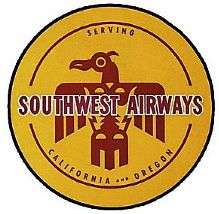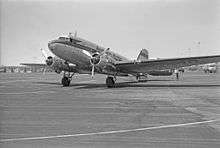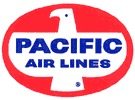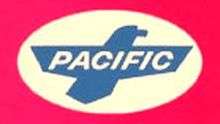Pacific Air Lines
 | |||||||
| |||||||
| Founded | 1941 | ||||||
|---|---|---|---|---|---|---|---|
| Commenced operations |
December 2, 1946 (renamed Pacific Air Lines, March 6, 1958) | ||||||
| Ceased operations | 1968 (merged with Bonanza Air Lines and West Coast Airlines to form Air West) | ||||||
| Hubs | San Francisco International Airport | ||||||
| Fleet size | 40 | ||||||
| Headquarters | San Francisco International Airport[1] | ||||||
| Key people |
John Howard Connelly Leland Hayward | ||||||
Pacific Air Lines was a regional airline (then called a "local service" air carrier as defined by the federal Civil Aeronautics Board) on the West Coast of the United States which began scheduled passenger operations in the mid 1940s under the name Southwest Airways. The company was essentially a feeder airline, primarily linking smaller communities in California with larger cities such as Los Angeles and San Francisco. Flights were also operated to Portland, Oregon, and eventually reached Las Vegas and Reno in Nevada.
Founded largely with money from investors from the Hollywood motion picture industry, the airline was noted for innovative safety practices and cost-saving procedures.[2] The name Pacific Air Lines passed into history in 1968 in a merger with Bonanza Air Lines and West Coast Airlines, forming Air West, which then became Hughes Airwest.
Southwest Airways era (1941–1958)

Founding and wartime operations
In early 1941, Air Service veteran John Howard "Jack" Connelly and noted Hollywood agent/producer Leland Hayward formed a business partnership that five years later evolved into a scheduled commercial airline. Neither man was a stranger to aviation; Connelly was also a former test pilot, airplane salesman, Civil Aeronautics Administration instructor pilot, and inspector for the 1930s-era Soviet Union. Hayward was an active private pilot and was on the board of directors of Transcontinental and Western Airlines (TWA). The two men enlisted the support of commercial pilot and photographer John Swope to oversee the training of aviation cadets.[3] Together, they founded a maintenance depot for overhauling training aircraft, a wartime air cargo line, and a military pilot training complex consisting of Thunderbird Field No. 1, Thunderbird Field No. 2, and Falcon Field in Arizona.[4] By the end of World War II, Southwest Airways was the largest training contractor in the United States, and trained more than 20,000 pilots from over 24 countries.[5]
Start of scheduled service

After the war, Connelly and Hayward raised $2,000,000 from investors including James Stewart and Darryl Zanuck to expand Southwest into the airline business, pending government approval.[2] They were awarded a three-year experimental charter from the Civil Aeronautics Board on May 22, 1946, for their feeder service.[6]
Scheduled flights began on December 2, 1946, with war-surplus C-47s, the military version of Douglas DC-3 converted for civil use.[7] The initial route was Los Angeles to San Francisco with stops in Oxnard, Santa Barbara, Santa Maria, San Luis Obispo, Paso Robles, Coalinga, Monterey, Santa Cruz/Watsonville, and San Jose. The north coastal route included Oakland, Vallejo/Napa, Santa Rosa, Ukiah, Fort Bragg, Eureka/Arcata, and Crescent City, while the inland route included Oakland, Sacramento, Marysville/Yuba City, Oroville, Chico, Red Bluff, Redding, and Yreka with Medford, Oregon, added later. By the late 1950s, Pacific Air Lines was serving Catalina Airport on Santa Catalina Island off the coast of southern California with flights from Los Angeles (LAX), Long Beach (LGB) and Burbank (BUR, now Bob Hope Airport.[8] In 1960, a Crescent City to Portland, Oregon, flight was added.[6]
In August 1953, Southwest scheduled flights to 23 airports, all in California except for Medford. In May 1968, Pacific flew to 29 airports.
No-frills spirit and quick turnarounds
Connelly serves no food ("let them bring their own"), provides no chewing gum ("we never fly high enough to need it and besides it sticks to the floor") or magazines ("takes too long to unwrap them")
Connelly, president, and Hayward, board chairman, were the majority owners of the airline, and as such could hold sway concerning how the company would operate. Running on slim operating margins, Southwest Airways was a no-frills airline decades before low-cost carriers became common.
The airline speeded ground operations to the point where a DC-3 could load and discharge passengers and begin taxiing for takeoff 90 seconds after coming to a stop (adding six minutes if fuel is needed).[2] To save money, the airline had its own pilots do the refueling instead of paying airport personnel.[2] Ground time was reduced by keeping one engine running while a male purser quickly escorted passengers to and from the plane.[2] Pacific's DC-3s were modified with an 'airstair', a door that doubled as a staircase for passengers.[9] The airstair eliminated waiting for a ground crew to roll a wheeled staircase up to the plane.
In August 1953, a daily Southwest DC-3 was scheduled from SFO to LAX in 3 hours and 45 minutes with eight stops.
Pioneering instrument landings
The airline's innovative spirit extended into air safety, as well: in December 1947, a Southwest Airways DC-3 flying into the coastal town of Arcata made the world's first blind landing by a scheduled commercial airliner using ground-controlled approach radar, instrument landing system devices, and fog investigation and dispersal operation oil-burning units adjacent to the runway.[2] By the following year, the airline had made 1,200 routine instrument landings at the often fog-shrouded Arcata airport.[2]
By 1948, Southwest had a fleet of 10 planes, all Douglas DC-3s, and was flying between 24 airports in California and Oregon, thus becoming the second-largest feeder airline in the United States.[2]
Crash of Flight 7
The airline had no fatal accidents until the evening of April 6, 1951, when Southwest Airways Flight 7 crashed, killing all 19 passengers and three crew members,[10] including 12 military personnel.[11] The DC-3 was flying a 20-minute route between Santa Maria and Santa Barbara. The aircraft struck a ridge in the Refugio Pass region of the Santa Ynez Mountains at an elevation of 2,740 ft (835 m), far below the minimum nighttime altitude of 4,000 ft (1,219 m) prescribed for the route over that stretch of mountains. The Civil Aeronautics Board was unable to determine the cause.[12]
Fleet expansion
By late 1952, the airline's fleet included eight secondhand piston-engined Martin 2-0-2s, faster and larger than the DC-3.[13][note 1] In the 1950s, the airline's literature said it reached 33 California locales (i.e. 24 airports) and timetables in the mid-1950s boasted that Southwest Airways "serves more California cities than any other scheduled airline."[14]
Pacific Air Lines era (1958–1968)

The airline became Pacific Air Lines on March 6, 1958.[6] The corporate logo was changed from an earth-toned Thunderbird reminiscent of a Navajo sandpainting to a simpler, modern design with bright colors. In a move possibly designed to prevent the flying public from confusing the newly named Pacific Air Lines for a brand-new airline, company timetables published in 1959[15] asserted that the company was in its "17th year of scheduled service".[note 2]
Like other local-service airlines, Pacific was subsidized; in 1962, its operating "revenues" of $12.1 million included $4.1 million in federal subsidy.[16]
Prop and turboprop transition

In 1959, Pacific added the first of 14 secondhand pressurized Martin 4-0-4 "Martinliners".[13] Pacific's first turbine-powered aircraft, the Fairchild F-27 twin turboprop (a U.S.-built version of the Dutch-manufactured Fokker F27 Friendship) was also added to the fleet. In 1960, a gradual phase-out of the DC-3s began with the last of 13 leaving Pacific's fleet by mid-1964,[17] and the last Martin 2-0-2s were retired in March 1964.[18][19] The Martin 4-0-4s and Fairchild F-27s then became the workhorses of Pacific's fleet. One F-27 route during summer of 1964 was a "milk run" featuring numerous stops: flight 771 flew Reno-Lake Tahoe-Sacramento-San Francisco-San Jose-Fresno-Bakersfield-Burbank-Los Angeles-San Diego. It left Reno at 6:00 am and was scheduled to arrive San Diego at 12:10 pm.
Flights to Las Vegas started in 1957, to Reno and San Diego in 1962, and to Lake Tahoe in 1964. Portland and Medford in Oregon, as well as Reno and Las Vegas in Nevada, were the only cities Pacific ever served outside California.
Hijacking attempt
The first U.S. hijacking attempt took place on board a Pacific Air Lines plane on the ground at the Chico airport on July 31, 1961. The pilot and a ticket agent were both shot; however, the assailant was then overpowered by the copilot and passengers while the plane was on the ground.[20]
Crash of Flight 773
On May 7, 1964, Pacific Air Lines Flight 773 crashed near San Ramon, California. All 44 aboard the Fairchild F-27 turboprop were killed when the aircraft dove into a hillside at a nearly 90° angle.[21] Investigators found a gun in the wreckage, and the FBI determined that a suicidal passenger shot both of the pilots, and then himself, causing the plane to dive out of control. This scenario was repeated many years later at another California-based airline, Pacific Southwest Airlines, when a former employee shot both pilots on board a British Aerospace BAe 146-200 Pacific Southwest Airlines Flight 1771 en route from Los Angeles to San Francisco, causing it to crash in the hills of San Luis Obispo County, California, with the loss of all on board.[22]
Boeing 727s join the fleet

On September 13, 1965, Pacific Air Lines announced it would acquire six new Boeing 727-100 jets, leasing two immediately and placing orders for the remainder to be delivered in early 1968.[23] The jets were ordered during a prosperous time for the airline, but net income for Pacific dropped from $700,337 in 1965 to $150,716,[24] chiefly because the 727 was uneconomical to operate on Pacific's short-haul routes. Two were then leased to National Airlines.[25]
During 1966-1968, Pacific Air Lines served the following cities with the Boeing 727-100:
- Bakersfield, CA (BFL)
- Burbank, CA (BUR) - now Bob Hope Airport
- Eureka/Arcata, CA (ACV)
- Fresno, CA (FAT)
- Las Vegas, NV (LAS)
- Los Angeles, CA (LAX)
- Monterey, CA (MRY)
- Reno, NV (RNO)
- San Francisco, CA (SFO) - headquarters for the airline
- San Jose, CA (SJC)
- Santa Barbara, CA (SBA)
- South Lake Tahoe, CA (TVL)
The airline promoted the Boeing 727 with the following statement in a 1966 print ad: "Pacific Air Lines jets to more California cities than any other airline." [26] The ad stated that Pacific was serving Fresno, Bakersfield, Monterey, Lake Tahoe, Los Angeles, San Francisco, San Jose, and Santa Barbara with the 727.
One early 727 route was San Francisco-Monterey-Santa Barbara-Los Angeles which according to the January 1967 timetable was served with three daily roundtrips. According to Pacific Air Lines system timetables during the late 1960s, the carrier was operating nonstop 727 flights between Burbank and San Francisco, between Burbank and Las Vegas, between Los Angeles and San Jose, between San Francisco and Eureka/Arcata, between San Jose and Las Vegas, and roundtrip routings of Los Angeles-Bakersfield-Fresno-San Francisco.[27] In 1968, the airline was flying 727s Los Angeles-Fresno-San Francisco-Eureka/Arcata, San Francisco-Monterey-Los Angeles, and Los Angeles-Fresno-Reno. Pacific also flew 727s nonstop from Fresno to Las Vegas, and nonstop from Fresno and San Jose to Reno. The airline pioneered scheduled jet service to Bakersfield, Eureka/Arcata, Fresno, Lake Tahoe, Monterey, and Santa Barbara with the 727.
Pacific planned to order Boeing 737-200s which were more economical to operate than the 727s. However, events overtook the airline in the form of a merger to form Air West and the order was cancelled.
After the merger with Bonanza Air Lines and West Coast Airlines, the new Air West soon removed Pacific's 727s from the fleet, although they were operated in scheduled service for a brief time to such cities as Las Vegas, Los Angeles, Monterey, San Francisco, Santa Barbara, and Salt Lake City.[28] The primary jet aircraft types operated by Air West were Douglas DC-9-10s with these twin-jet types being flown by Bonanza and West Coast. New McDonnell Douglas DC-9-30s soon joined the fleet, as well. The successor to Air West, Hughes Airwest, then added Boeing 727-200s in the 1970s. Air West and Hughes Airwest retained Pacific's Fairchild F-27 turboprops as Bonanza and West Coast also operated the F-27.
Controversial ad campaign
In 1967, the airline embarked on a controversial advertising campaign, including a full-page ad in the New York Times on April 28, 1967, that highlighted the fear of flying, a subject rarely mentioned by airlines. Pacific had hired award-winning advertising executive and comedian Stan Freberg for the ad campaign,[29] knowing that unconventional ideas were his forté. Under his direction, print advertisements said::
| “ | Hey there! You with the sweat in your palms. It's about time an airline faced up to something: Most people are scared witless of flying. Deep down inside, every time that big plane lifts off that runway, they wonder if this is it, right? You want to know something, fella? So does the pilot, deep down inside.[29] | ” |
The copy from another ad said:
| “ | Hey there, you with the sweat in your palms. Do you wish the pilot would knock off all that jazz about 'That's Crater Lake on the left, ladies and gentlemen,' and tell you instead what the devil that funny noise was you just heard?[30] | ” |
To complement the ad campaign, flight attendants handed out "survival kits" featuring hot-pink lunch pails containing a small security blanket,[24] a "lucky" rabbit's foot, the best-selling book The Power of Positive Thinking, and a fortune cookie containing the slogan "It could be worse. The pilot could be whistling 'The High and the Mighty'."[31] The attendants were also encouraged to exclaim "We made it! How about that!" upon landing.[29] Freberg had unfulfilled plans to paint a Pacific Boeing 727 to resemble a locomotive, with wheels on the fuselage and a cowcatcher on the nose.[24] Inside the cabin, passengers would have heard a recording of a steam locomotive over the loudspeakers.[24]
Matthew E. McCarthy, Pacific's chief executive and biggest shareholder, explained the campaign: "It's basically honest. We spoof the passengers' concern, but at least we admit they have it."[24] Philip H. Dougherty, writing in the Business and Finance section of the May 1 edition of The New York Times, described the advertisements as "rather shocking".[32] Objections to the unorthodox campaign were raised at a May 1967 stockholders meeting, and two Pacific Air Lines executives resigned in the wake of the controversy.[33]
Merger
When the Boeing 727 jet order was optimistically announced by the airline in 1965, it was unforeseen that a change in the business climate was on the horizon and that economic realities would dictate that some of the jets would not actually end up flying under the Pacific Air Lines banner. Stiff competition from rival air carriers such as Pacific Southwest Airlines and United Air Lines were factors in Pacific Air Lines joining forces with Bonanza Air Lines and West Coast Airlines in a three-way merger which resulted in the creation of Air West in 1968. Air West later became Hughes Airwest, which was subsequently merged into Republic Airlines in 1980. Republic, in turn, was acquired by Northwest Airlines in 1987. Northwest was then merged into Delta Air Lines in 2008. At the time of the Air West merger, Pacific's fleet included 11 of their workhorse Fairchild F-27s, five Martin 4-0-4s,[13] and three Boeing 727-100s, one of which was still leased out, but returned to Air West in late 1968.[19] The last of the increasingly obsolete Martins were not carried forward into the Air West fleet and were disposed of in August 1968.[13][34]
The two cofounders of Southwest Airways died within nine months of each other in 1971. John Connelly was 71,[35] and Leland Hayward was 68.
Destinations in 1968
The April 28, 1968, timetable lists Pacific Air Lines flights to the following destinations just before its merger.[36]
CALIFORNIA:
- Bakersfield (BFL)
- Burbank (BUR) - now Bob Hope Airport
- Chico (CIC)
- Crescent City (CEC)
- Eureka/Arcata (ACV)
- Fresno (FAT)
- Inyokern (IYK)
- Lake Tahoe (TVL)
- Long Beach (LGB)
- Los Angeles (LAX)
- Marysville/Yuba City (MYV)
- Monterey (MRY)
- Oxnard/Ventura (OXR)
- Palmdale/Lancaster (PMD)
- Paso Robles (PRB) - San Luis Obispo was served via Paso Robles at this time.
- Redding (RDD) - Red Bluff was served via Redding at this time.
- Sacramento (SMF)
- San Diego (SAN)
- San Francisco (SFO) - headquarters for the airline
- San Jose (SJC)
- Santa Barbara (SBA)
- Santa Maria (SMX)
- Santa Rosa (STS)
- Stockton (SCK)
- Vandenberg Air Force Base (VBG) - Passenger access was restricted: "The right of passengers to enplane or deplane at Vandenberg AFB is subject to Military Security Control."[36]
NEVADA:
OREGON:
- Portland (PDX)
Fleet
- Boeing 727-100 - only jet aircraft type operated by the airline
- Douglas DC-3 (operated by predecessor Southwest Airways and also by Pacific Air Lines, the air carrier also operated the C-47 version of the DC-3)
- Fairchild F-27
- Martin 2-0-2 (operated by predecessor Southwest Airways and also by Pacific Air Lines)
- Martin 4-0-4 (operated by predecessor Southwest Airways and also by Pacific Air Lines)
Notes
- Notes
- ↑ The Martin 2-0-2s had airstairs like the DC-3, but unlike the DC-3s, the Martin planes had tricycle landing gear, so the airstair was underneath the tail instead of on the side of the fuselage. (photo)
- ↑ The airline may have been engaging in some creative license, overstating by several years the actual amount of time they had been in scheduled passenger service. This reminder to the public of the airline's longevity, accurate or not, continued until mid-1964, when it disappeared from the timetable covers.(see Collector's Guide to Airline Timetables)
References
- ↑ "Pacific Air Lines" (PDF). Flight International: 523. April 2, 1964.
- 1 2 3 4 5 6 7 8 9 Small-Town Big-Timer. TIME, October 18, 1948. Retrieved January 29, 2007 - article about the earliest years of Southwest Airways
- ↑ Preston Lerner, Air and Space magazine, Oldies and Oddities: Tinseltown’s Training Base, Retrieved January 22, 2010
- ↑ Thunderbird Man. TIME, February 8, 1943. Retrieved January 29, 2007 - describes the early efforts in financing Southwest Airways
- ↑ Stars and the Sky, Hollywood and the Makings of Thunderbird. Duncan Boothby, Das Tor, The Garvin School of International Management, May 15, 2005
- 1 2 3 Jones, Geoff (2005), Northwest Airlines, The First 80 Years. Arcadia Publishing. p. 82. Retrieved August 4, 2009
- ↑ Davies, 1998, p. 620
- ↑ http://www.timetableimages.com, Dec. 1, 1959 Pacific Air Lines system timetable
- ↑ Photograph of a passenger using a Southwest Airways DC-3 airstair. Retrieved August 14, 2009.
- ↑ Southwest Airways Flight 7. Aviation Safety Network. Retrieved January 29, 2007.
- ↑ "Bodies Removed From Plane Wreck". St. Petersburg Times. AP. April 9, 1951. p. 1.
- ↑ "Accident Report, Southwest Airways incident of April 6, 1951, Docket No: SA-232 File No: 1-0019". Civil Aeronautics Board. November 5, 1951. Retrieved January 20, 2015.
- 1 2 3 4 Killion, 1997, p. 142
- ↑ southw1.jpg TimeTableImages.com. Retrieved January 29, 2007.
- ↑ pc590701.jpg TimeTableImages.com. Retrieved January 29, 2007.
- ↑ Moody's Transportation Manual 1964
- ↑ Gradidge, 2006, p. 234
- ↑ Killion, 1997, p.142
- 1 2 Southwest Airways / Pacific Air Lines fleet list.Aeromoe's U.S. Airlines Fleets. Retrieved February 5, 2007.
- ↑ Aylworth, Rodger (2011-07-31). "50 years ago today, Chico became site of first U.S. skyjacking attempt". Chico ER. Retrieved January 20, 2015.
- ↑ "Accident Report, Pacific Air Lines incident of May 7, 1964, File No: 1-0017". Civil Aeronautics Board. October 28, 1964. Retrieved January 20, 2015.
- ↑ "The Crash of Pacific Air Lines Flight #773". check-six.com.
- ↑ Pacific Will Fly Short-range Jets; Coast Airline to Acquire 6 Planes From Boeing.The New York Times. September 14, 1965. Retrieved January 29, 2007.
- 1 2 3 4 5 Airlines: Hey There, Sweaty Palms!. TIME, May 12, 1967. Retrieved August 18, 2009 - describes controversial 1967 ad campaign
- ↑ Airlines: How to Make Ten from Three. TIME, September 1, 1967. Retrieved August 18, 2009 - describes proposed merger with Bonanza and West Coast
- ↑ http://www.departedflights.com, 1966 Pacific Air Lines print ad
- ↑ http://pacificairlinesportfolio.com, Schedules
- ↑ Oct. 27, 1968 Air West timetable
- 1 2 3 Flight Safety Foundation newsletter, May-June 1988 - fear of flying article
- ↑ Advertising; In Lieu of Satisfaction's Lure, A Threat of Consumer Peril. The New York Times. August 5, 1992. Retrieved August 18, 2009.
- ↑ Zullo, Allan & Nelson, Kathy (2002), The Smile-High Club. Andrews McMeel Publishing. p.189 Retrieved August 17, 2009
- ↑ Advertising: On How to Get Talked About. Philip H. Dougherty, The New York Times, May 1, 1967. Retrieved January 29, 2007.
- ↑ Pacific Executives Quit.The New York Times, May 9, 1967. Retrieved January 29, 2007.
- ↑ Air West fleet list.Aeromoe's U.S. Airlines Fleets. Retrieved February 5, 2007.
- ↑ John H. Connelly, 71 dies. Phoenix Arizona Republic, December 30, 1971, Obituaries p. 53
- 1 2 timetableimages.com, Pacific Air Lines April 28, 1968 system timetable
Further reading
- Davies, R.E.G (1998). Airlines of the United States since 1914. Smithsonian Institution Press. ISBN 1-888962-08-9.
- Gradidge, Jennifer (2006). The Douglas DC-1/2/3 The First Seventy Years. Air-Britain (Historians) Ltd. ISBN 0-85130-332-3.
- Killion, Gary (1997). The Martinliners. Airways International Inc. ISBN 0-9653993-2-X.
External links
| Wikimedia Commons has media related to Pacific Air Lines. |
- Period photographs from the Arizona Memory Project - including a photo of the airline co-founders, Connelly and Hayward
- The Ed Coates collection - pictorial history of U.S. Airlines, including photos of Southwest Airways and Pacific Air Lines aircraft
- Photographs of Pacific Air Lines aircraft - airliners.net
- Gallery of timetable covers for Southwest Airways and Pacific Air Lines - timetableimages.com
- Southwest Airways and Pacific Air Lines timetable covers from the 1940s 1950s 1960s - airtimes.com
- Southwest Airways / Pacific Air Lines aircraft fleet - lists registration numbers, aircraft types, dates of service
- Southwest Airways / Pacific Air Lines historical records - inventory of artifacts stored at the Minnesota Historical Society